Abstract
The purpose of the present study was to investigate the effect of different durations of half-time re-warm up (RW) on intermittent sprint performance. Using a randomized crossover design, 13 healthy men performed three trials, which consisted of two, 40-min intermittent exercises separated by a 15-min half-time. Half-time interventions were 15 min of seated rest (Control), 7 min of cycling at 70% of maximal heart rate (HRmax) (7 min RW), and 3 min of cycling at 70% of HRmax (3 min RW). The second 40-min intermittent exercise as an exercise performance test was the Cycling Intermittent-Sprint Protocol (CISP), which consisted of 10 s of rest, 5 s of maximal sprint, and 105 s of low-intensity exercise at 50% of VO2max, with the cycles repeated over the 40-min duration. The mean work during the maximal sprint in the initial 10 min of the CISP was higher in the both RW trials than in the control trial (control: 3638 ± 906 J, 7 min RW: 3808 ± 949 J, p < 0.05, 3 min RW: 3827 ± 960 J, p < 0.05). There were no significant differences among three trials for mean work at 10-20, 20-30, and 30-40 min of the CISP. In the initial 10 min of the CISP, the change in oxygenated hemoglobin concentration during the 105 s of exercise at 50% of VO2max, oxygen uptake, carbon dioxide production, and respiratory exchange ratio were higher in both RW trials than in the control trial (p < 0.05). The rating of perceived exertion after half-time interventions was higher in both RW trials than in the control trial (p < 0.05). In conclusion, the 3 min RW increased intermittent sprint performance after the half-time, compared with a traditional passive half-time practice, and was as effective in improving intermittent sprint performance as the 7 min RW.
Key points.
The present study compared the effect of RWs for 3 and 7 min on intermittent sprint performance.
Both RWs for 3 and 7 min were equally effective in improving intermittent sprint performance over the 10-min following half-time, compared with a traditional passive half-time practice.
The present study challenges the half-time practice, indicating that a RW for 3 min is beneficial in improving exercise performance after half-time.
Key words: Intermittent team sport, half-time conditioning strategy, warm up duration, exercise performance
Introduction
The amount of high-intensity running, known to be an important performance indicator for intermittent team sport players and referees (Krustrup et al., 2009; Mohr et al., 2003), decreases in the initial part of the second half (Bradley et al., 2009). The magnitude of decrement was approximately 10% compared with the same part of the first half (Lovell et al., 2013a). Edholm et al. (2015) have also suggested that decrements in sprint performance after the first half and before the second half were 3% and 5.6% compared with before the first half. Furthermore, a significant increase in muscle injury (i.e., non-contact injuries) risk has also been reported during the initial part of the second half (Woods et al., 2007). The impaired exercise performance and increased injury risk have been suggested to be due to a lack of physical preparation prior to the second half (Mohr et al., 2004). A traditional passive half-time practice leads to a major decrease in body temperature (i.e., core and muscle temperature), which is associated with impaired power output (Mohr et al., 2004; Sargeant, 1987) and increased muscle injury (Safran et al., 1989). To prevent impaired exercise performance and increased risk of injury, an appropriate half-time conditioning strategy is required.
The effectiveness of performing a half-time re-warm up (RW) (i.e., moderate-intensity exercise during half-time) in preventing the decrease in sprint, vertical counter-movement jump, and endurance exercise performance immediately after half-time has been addressed in previous efficacy studies (Edholm et al., 2015; Lovell et al., 2007; 2013b; Mohr et al., 2004; Russell et al., 2018; Yanaoka et al., 2018). However, while RWs appear to be beneficial, a recent review has indicated that the duration of RWs used in these previous studies (i.e., 6-7 min) (Edholm et al., 2015; Lovell et al., 2007; 2013b; Mohr et al., 2004; Russell et al., 2018; Yanaoka et al., 2018) may not be applicable in actual matches (Russell et al., 2015). Indeed, Towlson et al. (2013) have suggested that only about 3 min was available for RW activities during half-time since time was needed for tactical, nutritional, and/or medical preparations for the second half. To our knowledge, the effectiveness of short duration (i.e., ~ 3 min) RW on exercise performance has not been addressed. Furthermore, it is not clear whether RW influences short duration sprints, interspersed with approximately 100 s recovery periods (i.e., intermittent sprint). It is necessary to employ an intermittent sprint performance test since intermittent team players undergo repeated short sprints, interspersed with 50-100 s recovery during a match (Bradley et al., 2009).
Oxygen availability is one of the most important factors for increasing intermittent sprint performance (Glaister, 2005). Increased oxygen availability improves intermittent sprint performance by increasing aerobic contribution for the re-synthesis of adenosine triphosphate during sprint and accelerating the re-synthesis of phosphocreatine after sprint (Glaister, 2005). The previous study has suggested that warm-up exercises increase baseline oxygen uptake (VO2) in subsequent exercise (Bishop, 2003). Moreover, warm-up enhances oxygen supply to the muscles via a vasodilation of blood vessels and an increase in blood flow to the muscles during subsequent exercise (Bishop, 2003). Thus, RW would have the same influence on those mechanisms. However, no studies have addressed the metabolic aspects of RW.
Therefore, the present study aimed to investigate the effect of different durations of RW on intermittent sprint performance. In the present study, cycling exercise was chosen since this mode of exercise is easier to control the intensity of the pre-determined exercise compared with running exercise (Hug and Dorel, 2009) – In particular, this ensures a similar exercise volume among the three trials before the RW activities during half-time and the subsequence exercise performance in the present study.
Methods
Participants
After approval from the Ethics Review Committee on Research with Human Subjects of Waseda University (Approval number: 2016-168), 13 healthy men who trained (i.e., more than an hour per session) for more than 2 days per week (age: 22.4 ± 2.1 years, height: 1.72 ± 0.05 m, body mass: 67.0 ± 10.1 kg, and maximal oxygen uptake (VO2max): 48.1 ± 4.1 ml·kg-1·min-1 [mean ± standard deviations (SD)]) gave written informed consent to participate in this study. The study was carried out in line with the Declaration of Helsinki.
Experimental design
This study was a randomized crossover design. Participants completed three trials, which consisted of two, 40-min intermittent exercises separated by a 15-min half-time. The three different half-time interventions (Control: 15 min of seated rest, 7 min RW: 7 min of cycling at 70% of maximal heart rate [HRmax], and 3 min RW: 3 min of cycling at 70% of HRmax) were performed during half-time. Exercise performance after half-time was evaluated using a Cycling Intermittent-Sprint Protocol, as previously described, to assess intermittent sprint performance in intermittent team sport athletes (Hayes et al., 2013). The high reliability of work during sprints in the Cycling Intermittent-Sprint Protocol was previously reported (i.e., intra-class correlation = 0.9) (Hayes et al., 2013).
Participants were asked not to alter their regular lifestyle habits, exercise, and diet throughout the study. Participants recorded all meals and drinks consumed the day before each trial and replicated their dietary intake in subsequent trials, ensuring that meals were standardized across trials. Participants refrained from intake of alcohol and caffeine for 24 h prior to each trial. Moreover, participants were required a 2-h fast except for water intake before each trial. The three trials commenced at the same time (i.e., between 9:30 am and 11:00 am). At least three days prior to the first trial, participants performed one practice trial to familiarize themselves with the experiment. All trials were separated by at least three days. The mean temperature and humidity were 20.7 ± 0.3°C and 50.3 ± 2.5% (mean ± SD), respectively.
Procedure
Participants initially attended the laboratory to perform a graded exercise test to determine VO2max and HRmax on a cycle ergometer (Monark 894E, Monark, Varberg, Sweden). The exercise test consisted of four, 3-min stages, which commenced at 95 W and increased by 25 W during each stage, followed by the incremental stages, which were 1 min in duration with 25 W increments until volitional exhaustion. The target cadence was 80 rpm. Breath-by-breath gas analysis was performed using an automatic gas analyzer (Quark CPET, COSMED, Rome, Italy). Heart rate was measured using a wireless HR monitor at 5-s intervals (Polar RCX3, Polar Electro, Kempele, Finland).
Schematic representation of the main trial is provided in Figure 1. First, participants rested on a chair for 5 min followed by a standardized warm-up (5 min at 95 W and a 30-s bout at 120 W with 30 s rest, cadence: 80 rpm) on a cycle ergometer (Monark 894E, Monark, Varberg, Sweden). Then, participants performed the first 40-min intermittent exercise. In the first 40-min intermittent exercise, each 2-min period started with 15 s of passive rest followed by 25 s of unloaded cycling. Next, 10 s of high-intensity exercise (i.e., 130% of VO2max) followed by 70 s of moderate-intensity exercise (i.e., 60% of VO2max) was completed. Pedal cadence during the first 40-min intermittent exercise was 80 rpm except for each 15 s of passive rest. The first 40-min intermittent exercise was based on the pilot work to determine that all participants could finish the required workload. In the half-time, participants either rested on the cycle ergometer for 15 min (Control), rested on the cycle ergometer for 7 min followed by cycling at 70% of HRmax for 7 min (7 min RW), or rested on the cycle ergometer for 11 min followed by cycling at 70% of HRmax for 3 min (3 min RW). The RW protocol was completed 1 min prior to beginning the second 40-min intermittent exercise. The exercise intensity of RWs has been described in previous studies (Edholm et al., 2015; Lovell et al., 2007; 2013b; Mohr et al., 2004; Russell et al., 2018; Yanaoka et al., 2018). Then, participants performed the Cycling Intermittent-Sprint Protocol (Hayes et al., 2013). The Cycling Intermittent-Sprint Protocol consisted of 20, 2-min periods. Each 2-min period started with 10 s of passive rest followed by a 5-s maximal sprint against a 7.5% body mass resistance. Next, 105 s of low-intensity exercise (50% of VO2max) is completed. Each sprint was initiated from a stationary start with the right pedal crank at approximately 90° to the horizontal. Pedal cadence during 105 s of low-intensity exercise during the Cycling Intermittent-Sprint Protocol was 80 rpm. To ensure the comparable intensity of the 40-min intermittent exercise among the three trials, we used different exercises before and after half-time.
Figure 1.
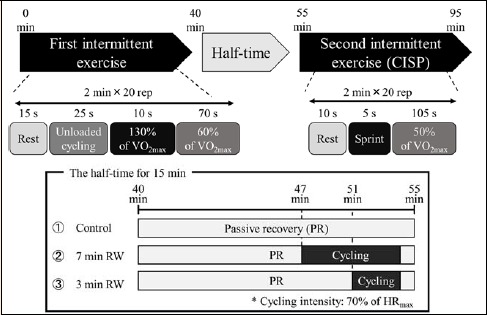
Schematic representation of the study protocol. CISP: The Cycling Intermittent-Sprint Protocol, Control: 15 min of seated rest trial, 7 min RW: 7 min of the cycling at 70% of HRmax trial, 3 min RW: 3 min of the cycling at 70% of HRmax trial.
Sprint measurements
Work for each sprint was calculated as the mean power output multiplied by duration (5 s), using the Anaerobic Test Software (Monark ATS Software, Monark, Varberg, Sweden).
Gas measurements
Breath-by-breath gas analysis was continuously performed using an automatic gas analyzer (Quark CPET, COSMED, Rome, Italy) from the pre, 0 to 40, and 54 to 65 min. The mean VO2, carbon dioxide production (VCO2), and respiratory exchange ratio (RER) were calculated.
Muscle oxygenation measurements
Muscle oxygenation of the right vastus lateralis, defined as 30% of the length between the patella and the greater trochanter, above the patella, was measured at 5 Hz using two-wavelength (770 and 830 nm) light-emitting diode near-infrared spatial resolved spectroscopy (NIRSRS: Hb14, ASTEM, Kanagawa, Japan) (Takagi et al., 2016). The NIRSRS probe consisted of one light source and two photodiode detectors, and the optode distances were 20 and 30 mm. The NIRSRS technique provides continuous, non-invasive monitoring of changes in oxygenated, deoxygenated, and total hemoglobin (Δoxy-Hb, Δdeoxy-Hb, and Δtotal-Hb, respectively) concentrations from rest before a standardized warm-up, and muscle oxygen saturation (SmO2). The thickness of fat layer greatly affects the NIRSRS variables when the NIRSRS technique is used (Niwayama et al., 2000). The previous review has suggested that the NIRS data can be corrected by using thickness of fat layer (Niwayama et al., 2012). Thus, thickness of fat layer at the measurement site was assessed using an ultrasound device (LogiQ3, GE Healthcare, Tokyo, Japan) before each trial, and Δoxy-Hb, Δdeoxy-Hb, Δtotal-Hb, and SmO2 were calculated using fat-correction software (Hb14, ASTEM, Kanagawa, Japan). The within-subject coefficient of variation for thickness of fat layer was 5.5 ± 4.9 %. The mean Δoxy-Hb, Δdeoxy-Hb, and Δtotal-Hb were calculated from the 0 to 40 and 54 to 65 min and the mean SmO2 was calculated from the pre, 0 to 40, and 54 to 65 min. The mean Δoxy-Hb at 105 s of low-intensity exercise during the Cycling Intermittent-Sprint Protocol were also calculated at 55-65 min. To ensure the same repositioning of the NIRS probe among the three trials, the probe placement was marked using a surgical marker.
Heart rate and rating of perceived exertion measurements
Heart rate was measured using a wireless HR monitor at 5-s intervals throughout the study (Polar RCX3, Polar Electro, Kempele, Finland). The mean HR was calculated at pre, 0-40, 54-55, 55-65, 65-75, 75-85, and 85-95 min. The rating of perceived exertion (RPE) (Borg, 1982) was assessed at pre, 40, 55, 65, 75, 85, and 95 min.
Statistical analyses
All values are shown as mean ± SD. Statistics were computed using SPSS computer software (Version 23.0, SPSS Japan Inc., Japan). The mean work, VO2, VCO2, Δoxy-Hb, Δdeoxy-Hb, Δtotal-Hb, SmO2, HR, and RPE were compared using repeated measures two-factor (trial × time) analysis of variance. The mean Δoxy-Hb at 105 s of low-intensity exercise at 55-65 min was compared using repeated measures one-factor (trial) analysis of variance. Where significant interaction and trial effects were found, the values were subsequently analyzed using a Bonferroni multiple comparisons test. The correlation coefficients were determined by using Pearson’s product-moment test. Partial-η2 is provided for an estimate of the effect size. The 95% confidence intervals (95% CI) for the mean absolute pairwise differences between trials were calculated using the t-distribution and degrees of freedom (n-1). Statistical significance was set at p < 0.05.
Results
Intermittent sprint performance
There was no main effect of trial for the mean work. There was a trial × time interaction (p < 0.05, partial η2 = 0.194) for the mean work. The mean work at 55-65 min was higher in both RW trials than in the control trial (Control: 3638 ± 906 J, 7 min RW: 3808 ± 949 J, p < 0.05, 95% CI: 4 – 336 J, 3 min RW: 3827 ± 960 J, p < 0.05, 95% CI: 39 – 338 J) (Figure 2a). There was no significant difference between 7 min and 3 min RW trials for the mean work at 55-65 min. The mean work at 55-65 min correlated to the mean Δoxy-Hb during 105 s of low-intensity exercise at 55-65 min (r = 0.52, p < 0.05, n = 39) (Figure 2b).
Figure 2.
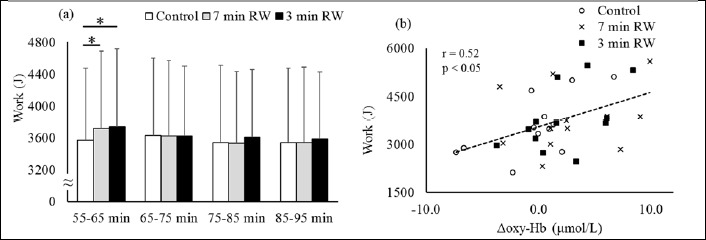
The mean work at each measurement point among three trials (a) and correlation between the mean work at 55-65 min and the mean of the changes in oxygenated hemoglobin concentration during low-intensity exercise in 55-65 min (b). Control: 15 min of seated rest trial, 7 min RW: 7 min of the cycling at 70% of HRmax trial, 3 min RW: 3 min of the cycling at 70% of HRmax trial. (n=13, mean ± SD). Means were compared by using repeated measures two-factor analysis of variance followed by a Bonferroni multiple comparisons test (Figure 2a). The mean work: a main effect of trial; p > 0.05, a main effect of time; p < 0.05, interaction; p < 0.05. * Significantly different from the control trial (p < 0.05). The correlation coefficients were determined by using Pearson’s product-moment test (Figure 2b).
Gas analysis
The mean values of VO2, VCO2, and RER at 54-65 min are provided in Figure 3. There was a main effect of trial (VO2: p < 0.05, partial η2 = 0.688, VCO2: p < 0.05, partial η2 = 0.726, RER: p < 0.05, partial η2 = 0.565). The mean VO2, VCO2, and RER were higher in both RW trials than in the control trial (VO2: control, 27.1 ± 1.2 ml·kg-1·min-1, 7 min RW, 29.2 ± 0.8 ml·kg-1·min-1, p < 0.05, 95% CI: 1.2 – 3.0 ml/kg/min, 3 min RW trial, 29.5 ± 0.9 ml·kg-1·min-1, p < 0.05, 95% CI: 1.3 – 3.5 ml·kg-1·min-1, VCO2: control, 24.7 ± 1.3 ml·kg-1·min-1, 7 min RW, 27.6 ± 0.8 ml·kg-1·min-1, p < 0.05, 95% CI: 1.6 – 4.1 ml·kg-1·min-1, 3 min RW, 27.9 ± 0.9 ml·kg-1·min-1, p < 0.05, 95% CI: 1.9 – 4.6 ml·kg-1·min-1, RER: control, 0.91 ± 0.02,7 min RW, 0.95 ± 0.02, p < 0.05, 95% CI: 0.01 – 0.07, 3 min RW, 0.95 ± 0.02, p < 0.05, 95%CI: 0.02 – 0.07). There was a trial × time interaction (VO2: p < 0.05, partial η2 = 0.517, VCO2: p < 0.05, partial η2 = 0.492, RER: p < 0.05, partial η2 = 0.284) for the mean VO2, VCO2, and RER. Oxygen uptake was higher in the 7 min RW trial than in the control trial at 54 min 0 s - 55 min 40 s and 59 min 30-50 s, and it was higher in the 3 min RW trial than in the control trial at 54 min 0 s - 55 min 40 s, 57 min 30-50 s, and 59 min 30-50 s (Figure 3a). Carbon dioxide production was higher in both RW trials than in the control trial at 54 min 0 s – 55 min 60 s and 57 min 30-50 s, and it was higher in the 3 min RW trial than in the control trial at 59 min 40 s – 60 min 20 s (Figure 3b). Respiratory exchange ratio was higher in both RW trials than in the control trial at 54 min 50 s – 56 min 60 s and 57 min 30 s – 58 min 30 s (Figure 3c). There were no significant differences among the three trials for VO2, VCO2, and RER at pre and 0-40 min (Table 1).
Figure 3.
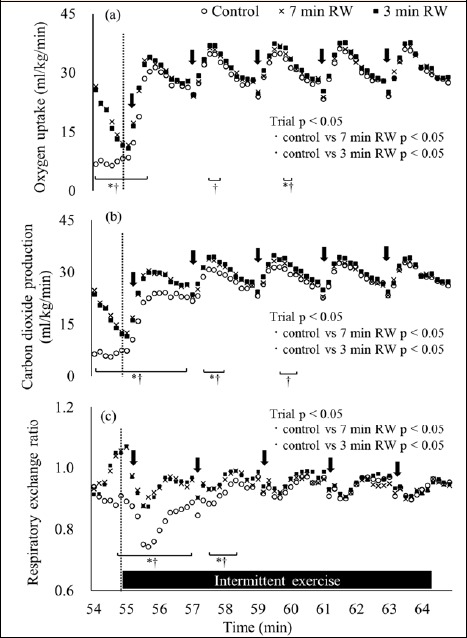
Oxygen uptake (a), carbon dioxide production (b), and respiratory exchange ratio (c) of the mean values at 54-65 min. Data are displayed as 10-s averages. Arrow represents 5-s sprints of the second intermittent exercise. Error bars is omitted for clarity. Control: 15 min of seated rest trial, 7 min RW: 7 min of the cycling at 70% of HRmax trial, 3 min RW: 3 min of the cycling at 70% of HRmax trial. (n=13, mean). Means were compared by using repeated measures two-factor analysis of variance followed by a Bonferroni multiple comparisons test. Oxygen uptake: a main effect of trial; p < 0.05, a main effect of time; p < 0.05, interaction; p < 0.05. Carbon dioxide production: a main effect of trial; p < 0.05, a main effect of time; p < 0.05, interaction; p < 0.05. Respiratory exchange ratio: a main effect of trial; p < 0.05, a main effect of time; p < 0.05, interaction; p < 0.05. * Significantly different between the control and the 7 min RW trials (p < 0.05). † Significantly different between the control and the 3 min RW trials (p < 0.05).
Table 1.
Gas analysis, heart rate, and rating of perceived exertion at pre and 0-40 min. Data are means (±SD).
| Control | 7 min RW | 3 min RW | ||
|---|---|---|---|---|
| VO2 (ml·kg-1·min-1) | pre | 5.5 (0.9) | 5.6 (0.8) | 5.4 (0.6) |
| 0-40 min | 28.4 (3.2) | 28.1 (3.5) | 28.8 (3.5) | |
| VCO2 (ml·kg-1·min-1) | pre | 4.9 (0.8) | 5.0 (0.7) | 4.8 (0.5) |
| 0-40 min | 27.2 (3.1) | 26.9 (3.5) | 27.5 (3.6) | |
| RER (A.U.) | pre | 0.88 (0.03) | 0.88 (0.04) | 0.88 (0.05) |
| 0-40 min | 0.95 (0.03) | 0.95 (0.02) | 0.95 (0.03) | |
| HR (%HRmax) | pre | 36(5) | 36(4) | 36(4) |
| 0-40 min | 71(5) | 70(6) | 71(4) | |
| RPE (A.U.) | pre | 6.3 (0.6) | 6.4 (0.7) | 6.2 (0.4) |
| 0-40 min | 12.6 (2.0) | 12.6 (1.9) | 11.9 (1.8) | |
Control: 15 min of seated rest trial, 7 min RW: 7 min of the cycling at 70% of HRmax trial, 3 min RW: 3 min of the cycling at 70% of HRmax trial, VO2: oxygen uptake, VCO2: carbon dioxide production, RER: respiratory exchange ratio, HR: heart rate, RPE: rating of perceived exertion. (n=13).
NIRSRS
The changes in the mean values of the NIRSRS variables at 54-65 min are provided in Figure 4. There was no main effect of trial for Δoxy-Hb, Δdeoxy-Hb, Δtotal-Hb, and SmO2. There was a trial × time interaction for Δoxy-Hb, Δdeoxy-Hb, Δtotal-Hb, and SmO2 (Δoxy-Hb: p < 0.05, partial η2 = 0.188, Δdeoxy-Hb: p < 0.05, partial η2 = 0.655, Δtotal-Hb: p < 0.05, partial η2 = 0.202, SmO2: p < 0.05, partial η2 = 0.498). Δoxy-Hb was higher in the 7 min RW trial than in the control trial at 54 min 0-10 s, 55 min 30 s – 56 min 10 s, and 56 min 50-60 s, and it was higher in the 3 min RW trial than in the control trial at 54 min 0-10 s, 55 min 30 s – 56 min 60 s, 57 min 40 s – 58 min 40 s, and 59 min 30 s – 60 min 30 s (Figure 4a). Δdeoxy-Hb was higher in both RW trials than in the control trial at 54 min 0 s – 55 min 20 s (Figure 4b). Δtotal-Hb was higher in both RW trials than in the control trial at 54-55 min, and it was higher in the 7 min RW trial than in the control trial at 55 min 10-20 s (Figure 4c). SmO2 was higher in the 7 min RW trial than in the control trial at 54 min 0-40 s and 55 min 0-10 s, and it was higher in the 3 min RW trial than in the control trial at 54 min 0 s – 55 min 20 s (Figure 4d). There was a main effect of trial for the mean Δoxy-Hb during 105 s of low-intensity exercise at 55-65 min (p < 0.05, partial η2 = 0.292). It was significantly higher in both RW trials than in the control trial (control: 0.1 ± 3.8 µmol/L; 7 min RW: 2.8 ± 4.1 µmol/L, p < 0.05, 95% CI: 0.1 – 5.4 µmol/L; 3 min RW: 2.6 ± 3.7 µmol/L, p < 0.05, 95% CI: 0.3 – 4.8 µmol/L). There were no significant differences among three trials for Δoxy-Hb, Δdeoxy-Hb, Δtotal-Hb, and SmO2 at pre and 0-40 min (Table 2).
Figure 4.
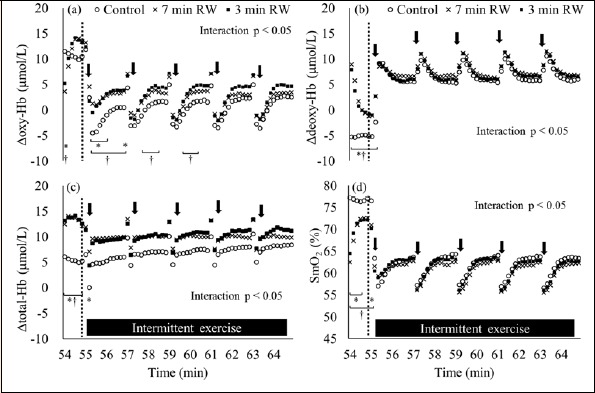
The changes in oxy-Hb (a), deoxy-Hb (b), and total-Hb (c) from the rest before a standardized warm-up, and SmO2 (d) of the mean values at 54-65 min. Data are displayed as 10-s averages. Arrow represents 5-s sprints of the second intermittent exercise. Error bars is omitted for clarity. Control: 15 min of seated rest trial, 7 min RW: 7 min of the cycling at 70% of HRmax trial, 3 min RW: 3 min of the cycling at 70% of HRmax trial. (n=13, mean). Means were compared by using repeated measures two-factor analysis of variance followed by a Bonferroni multiple comparisons test. Δoxy-Hb: a main effect of trial; p > 0.05, a main effect of time; p < 0.05, interaction; p < 0.05. Δdeoxy-Hb: a main effect of trial; p > 0.05, a main effect of time; p < 0.05, interaction; p < 0.05. Δtotal-Hb: a main effect of trial; p > 0.05, a main effect of time; p < 0.05, interaction; p < 0.05. SmO2: a main effect of trial; p > 0.05, a main effect of time; p < 0.05, interaction; p < 0.05. * Significantly different between the control and the 7 min RW trials (p < 0.05). † Significantly different between the control and the 3 min RW trials (p < 0.05)
Table 2.
The changes in oxy-Hb, deoxy-Hb, and total-Hb from the rest before a standardized warm-up, and SmO2 at pre and 0-40 min. Data are means (±SD).
| Control | 7 min RW | 3 min RW | ||
|---|---|---|---|---|
| Δoxy-Hb (μmol/L) | pre | - | - | - |
| 0-40 min | -2.5 (3.7) | -0.6 (6.8) | 0.1 (3.5) | |
| Δdeoxy-Hb (μmol/L) | pre | - | - | - |
| 0-40 min | 7.0 (3.7) | 7.1 (3.8) | 7.8 (3.5) | |
| Δtotal-Hb (μmol/L) | pre | - | - | - |
| 0-40 min | 4.4 (3.8) | 5.8 (6.3) | 7.9 (2.8) | |
| SmO2 (%) | pre | 67.6 (4.5) | 66.5 (4.4) | 66.4 (4.8) |
| 0-40 min | 60.3 (5.5) | 59.7 (5.0) | 59.6 (6.4) | |
Control: 15 min of seated rest trial, 7 min RW: 7 min of the cycling at 70% of HRmax trial, 3 min RW: 3 min of the cycling at 70% of HRmax trial. (n=13).
HR and RPE
There were a main effect of trial (p < 0.05, partial η2 = 0.404) and trial × time interaction (p < 0.05, partial η2 = 0.779) for the mean HR. There were no significant differences among three trials for the mean HR at pre and 0-40 min (Table 1). The mean HR at 54-55 min was higher in both RW trials than in the control trial (control: 48 ± 5 %, 7 min RW: 66 ± 8 %, p < 0.05, 95% CI: 12.3 – 24.6 %; 3 min RW: 63 ± 6 %, p < 0.05, 95% CI: 10.1 – 20.8 %). The mean HR at the 55-65 min was higher in the 3 min RW trial than in the control trial (control: 70 ± 5 %, 3 min RW: 74 ± 4 %, p < 0.05, 95% CI: 0.7 – 6.8 %). It tended to be higher in the 7 min RW trial than in the control trial (7 min RW: 74 ± 6 %, p = 0.062, 95% CI: -0.2 – 7.7 %).
There were a main effect of trial (p < 0.05, partial η2 = 0.462) and trial × time interaction (p < 0.05, partial η2 = 0.408) for the RPE. There was no significant difference among the three trials for the RPE at pre and 40 min (Table 1). The RPE at 55 min was higher in both RW trials than in the control trial (control: 8.2 ± 1.7, 7 min RW: 11.8 ± 1.7, p < 0.05, 95% CI: 1.7 – 5.7, 3 min RW: 10.8 ± 1.5, p < 0.05, 95% CI: 0.7 – 4.5). It was also higher in the 7 min RW trial than in the 3 min RW trial (p < 0.05, 95% CI: 0.1 – 2.1). The RPE at 65 min was higher in the 7 min RW trial than in the control trial (control: 12.2 ± 1.5, 7 min RW: 13.2 ± 1.2, p < 0.05, 95% CI: 0.1 – 2.0).
Discussion
The present study is, to our knowledge, the first to investigate how different durations of RW can affect intermittent sprint performance. The present findings demonstrate that both RWs increase work at 55-65 min compared with the control trial. Moreover, we observed a comparable increase in work at 55-65 min after performing both a 3 min RW (4.7%) and 7 min RW (4.1%). The magnitude of increase rates in sprint performance after both RWs were similar to the range previously reported (Lovell et al., 2013b: 5.0%; Mohr et al., 2004: 4.0%). Thus, the 3 min RW has an equally positive influence on intermittent sprint performance over the 10-min following half-time compared with the 7 min RW. Towlson et al. (2013) have suggested that RW for 7 min may not be appropriate in professional football matches since players have limited time (i.e., 3 min) available for RW. Moreover, the present study has demonstrated that RPE at 55 min was lower in the 3 min RW trial than the 7 min RW trial despite no differences in intermittent sprint performance between both RW trials. These results are important in supporting the implementation of a 3 min RW protocol in practice for intermittent team sports. Relaxing from the psychological demand of the first half is important during the half-time for players (Russell et al., 2015). Therefore, the present findings indicate that the 3 min RW, which can be easily performed in actual matches, due to less exercise duration and psychological load, would be recommended to increase intermittent sprint performance in the initial part of the second half.
In the present study, metabolic aspects of RW were considered since no studies have addressed this issue (Russell et al., 2015). In particular, oxygen availability in the muscle is one of the most important factors for increasing intermittent performance since it accelerates the re-synthesis of phosphocreatine, which is directly related to the ability to produce high power outputs after sprints (Girard et al., 2011; Haseler et al., 1999; McCully et al., 1994; Spencer et al., 2005). The present study showed that both RW trials increased Δoxy-Hb during 105 s of low-intensity exercise at 55-65 min compared with the control trial and there was a correlation between the mean work during sprint and Δoxy-Hb during 105 s of low-intensity exercise at 55-65 min. Although the amount of re-synthesis of phosphocreatine cannot be calculated, the present study suggests that RW may increase oxygen availability in the muscle and may contribute to the re-synthesis of phosphocreatine after a sprint. These results are consistent with the previous study that investigated the influence of moderate intensity warm-up on muscular metabolism (Takizawa and Ishii, 2006).
The mechanism of increased Δoxy-Hb during 105 s of low-intensity exercise at 55-65 min in both RW trials may increase oxygen supply to the muscle. Δoxy-Hb is an indicator of the balance between oxygen supply and utilization (Takagi, 2016). There is little possibility that oxygen utilization was lower in both RW trials than in the control trial since work during sprints was higher in both RW trials than the control trial and no differences in the mean Δdeoxy-Hb, which is an indicator of the balance between oxygen unloading in the muscle and blood outflow from the muscle (Takagi, 2016), were observed among the three trials. In contrast, previous reviews have suggested that warm-up increases oxygen supply to the muscle via a vasodilation of blood vessels and an increase in blood flow to the muscles during subsequent exercise (Bishop, 2003; Jones et al., 2003). Indeed, Takizawa and Ishii (2006) have reported the relative changes in the oxy-Hb increased after warm-up, and this may occur due to the increased blood flow to the muscle and rightward shift in the oxy-Hb dissociation curve because of increased body temperature after warm-up. Therefore, the required amount of oxygen for restoration after a sprint may increase in both RW trials compared to the control trial.
The mean VO2 at 54-65 min was higher in both RW trials than in the control trial. The increase in mean VO2 after RWs observed in the present study is likely to be mediated by two potential mechanisms. The first is increased baseline VO2 by performing RW as this was the case in the present study. The previous study has suggested that moderate-intensity warm-up increased VO2 immediately before the main exercise (Takizawa and Ishii, 2006). Increased baseline VO2 reduces the oxygen deficit by increasing the contribution of aerobic metabolism (Bishop, 2003). The second is the increased requirement of oxygen for the restoration of the metabolic environment to a resting state in both RW trials. VO2 values remain increased for some time to re-synthesize phosphocreatine, metabolize lactate, and remove accumulated inorganic phosphate (Glaister, 2005). In the present study, intermittent sprint performance at 55-65 min was higher in both RW trials than the control trial. Therefore, the required amount of oxygen for restoration after a sprint may increase in both RW trials compared to the control trial.
The mean HR at 54-55 and 55-65 min were higher in the both RW trials than the control trial. The same results have been reported by the previous study regarding RW for professional football players in actual football matches (Edholm et al., 2015). The previous study has suggested that the HR immediately before the start of the second half was significantly higher in the RW condition compared with a traditional 15-min half-time condition, and the time for increasing values of mean HR during the second half was faster in the RW condition compared with a traditional 15-min half-time condition (Edholm et al., 2015). The previous study has suggested that there was a relationship between HR and VO2 during varying non-steady states exercise (Bot and Hollander, 2000). Therefore, increased mean HR may also contribute to increased VO2 in the present study.
The increase in mean VCO2 and RER following RWs may result from increased intermittent sprint performance. Anaerobic glycolysis is one of the main fuels for intermittent sprints (Glaister, 2005). Moreover, hydrogen ion accumulation occurs after sprints (Glaister, 2005). Hydrogen ion removal using sodium bicarbonate and CO2 was performed to avoid acidosis (Glaister, 2005). Therefore, both RW trials may require more anaerobic glycolysis and induce hydrogen ion, and these may increase VCO2 and RER at 54-65 min.
This study has several strengths. First, the Cycling Intermittent-Sprint Protocol, which is similar to the sprint activity pattern of intermittent team sport players (Bradley et al., 2009), was employed as an exercise performance test in the present study. Previous studies examined the effect of RW on a sprint performance before and after the second half (Lovell et al., 2013b; Mohr et al., 2004). Therefore, the sustained effect of RW on exercise performance was not clear. The present study examined sprint performance throughout the second half and showed that both RWs sustainably increased intermittent sprint performance over the 10-min following half-time. Second, pulmonary and muscular metabolism was examined in the present study. No similar study has addressed the metabolic aspects of RW on exercise performance. The present study shows that RW increased VO2, VCO2, RER, and Δoxy-Hb over the 10-min following half-time. Aerobic metabolism is also important for maintaining repeated-sprint (i.e., sprint interspersed with brief recovery [≤ 60 s]) ability. Aerobic metabolism contributes to approximately 40% of the total energy supply when repeated-sprint exercise is performed (Girard et al., 2011). Moreover, previous studies suggest that an increased oxygen availability in the muscle allows for greater re-synthesis of phosphocreatine between sprints (Haseler et al., 1999; McCully et al., 1994). Therefore, the present findings may provide important insight into the role that half-time RWs play in modulating energy metabolism.
Despite the insights provided by this study, there are limitations that need to be considered. First, cycling exercises were used as the performance indicator in the present study. Although cycling exercises were used for the assessment of the metabolic aspects of RW, actual intermittent team sports use over-ground running. Fitzsimons et al. (1993) have reported that there was a moderate correlation between repeated sprint performance performed on a cycle ergometer and during over-ground running (i.e., total work vs total run time). The results suggest that the mode of exercise is one of the factors affecting exercise performance and that sport-specific exercise modes are recommended for the assessment of exercise performance (Spencer et al., 2005). Moreover, the first 40-min intermittent exercise used in the present study is not comparable intensity to the first half in actual intermittent team sports and used cycling exercise. Therefore, it is not possible to conclude whether the present results can be applied for over-ground running activities and actual intermittent team sports, and it is necessary to determine whether the RW protocols used in the present study would have similar effects when other modes of exercise are performed for an extended period time after half-time in a future study. Second, although we tried to mark the probe placement spot to ensure the same position of the NIRS probe for each time there is no hard evidence to prove whether we put on the NIRS probe at exactly the same position during the three trials. The position of NIRS probe is very important since regional difference of SmO2 within the vastus lateralis was observed in the previous study (Takagi et al., 2013).
Practical applications
The match-day practices, such as warm-up and half-time, of intermittent team sports are very structured and rigid (Russell et al., 2015). Thus, it is important that a half-time strategy is considered for implementation in actual matches. The 7 min RW used in previous studies (Edholm et al., 2015; Lovell et al., 2007; 2013b; Mohr et al., 2004; Russell et al., 2018; Yanaoka et al., 2018) may likely be too long for practical implementation. In contrast, the 3 min RW used in the present study can feasibly be implemented in practice (Towlson et al., 2013). The present findings showed that a 3 min RW is as effective in improving intermittent sprint performance over the 10-min following half-time as 7 min RW at same intensity. Moreover, psychological load in the 3 min RW is lower than in the 7 min RW. Therefore, a short duration RW may be useful for coaches and players to increase exercise performance in the initial part of the second half.
Conclusion
Both RWs for 3 and 7 min were equally effective at increasing the intermittent sprint performance over the 10-min following half-time compared with a traditional passive half-time practice. These findings challenge a half-time practice by suggesting that a short duration of RW (i.e., 3 min) may also impart benefits for subsequent exercise performance.
Acknowledgements
The authors would like to thank the participants for their cooperation. The present study was supported by a Grant-in-Aid for JSPS Research Fellow (no: 17J02878); and internal funding from the Waseda University. The authors have no conflict of interest directly relevant to the content of the study. The authors declare the present study comply with the current laws of the country in which they were performed.
Biographies

Takuma YANAOKA
Employment
Graduate School of Sport Sciences, Waseda University, Saitama, Japan; Research Fellow of Japan Society for the Promotion of Science, Tokyo, Japan.
Degree
MSc
Research interest
Conditioning and physical performance.
E-mail: takumayanaoka@toki.waseda.jp

Kyoko KASHIWABARA
Employment
Graduate School of Sport Sciences, Waseda University, Saitama, Japan; Research Fellow of Japan Society for the Promotion of Science, Tokyo, Japan.
Degree
MSc
Research interest
Physical activity and health; Exercise and appetite regulation.
E-mail: k-kashiwabara@toki.waseda.jp
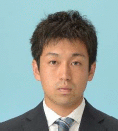
Yuta MASUDA
Employment
Graduate School of Sport Sciences, Waseda University, Saitama, Japan.
Degree
BSc
Research interest
Heat acclimation
E-mail: masuda-19@fuji.waseda.jp

Jumpei YAMAGAMI
Employment
Graduate School of Education, Tokyo Gakugei University, Tokyo, Japan.
Degree
MSc
Research interest
Functional nutrients and physical performance.
E-mail: m152225y@st.u-gakugei.ac.jp

Kuran KURATA
Employment
Graduate School of Education, Tokyo Gakugei University, Tokyo, Japan.
Degree
BSc
Research interest
Physical fitness and mental health.
E-mail: m162214w@st.u-gakugei.ac.jp

Shun TAKAGI
Employment
Faculty of Health and Sports Science, Doshisha University, Kyoto, Japan.
Degree
PhD
Research interest
Circulation and Metabolism in Skeletal Muscle.
E-mail: shtakagi@mail.doshisha.ac.jp

Masashi MIYASHITA
Employment
Faculty of Sport Sciences, Waseda University, Saitama, Japan.
Degree
PhD
Research interest
Physical Activity and Health; Exercise and Appetite Regulation; Functional Nutrients and Physical Performance.
E-mail: m.miyashita@waseda.jp

Norikazu HIROSE
Employment
Faculty of Sport Sciences, Waseda University, Saitama, Japan.
Degree
PhD
Research interest
Injury Prevention; Talent Identification and Development .
E-mail: toitsu_hirose@waseda.jp
References
- Bishop D. (2003) Warm up I: potential mechanisms and the effects of passive warm up on exercise performance. Sports Medicine 33, 439-454. [DOI] [PubMed] [Google Scholar]
- Borg G.A. (1982) Psychophysical bases of perceived exertion. Medicine & Science in Sports & Exercise 14, 377-381. [PubMed] [Google Scholar]
- Bot S.D., Hollander A.P. (2000) The relationship between heart rate and oxygen uptake during non-steady state exercise. Ergonomics 43, 1578-1592. [DOI] [PubMed] [Google Scholar]
- Bradley P.S., Sheldon W., Wooster B., Olsen P., Boanas P., Krustrup P. (2009) High-intensity running in English FA Premier League soccer matches. Journal of Sports Sciences 27, 159-168. [DOI] [PubMed] [Google Scholar]
- Edholm P., Krustrup P., Randers M.B. (2015) Half-time re-warm up increases performance capacity in male elite soccer players. Scandinavian Journal of Medicine & Science in Sports 25, e40-e49. [DOI] [PubMed] [Google Scholar]
- Fitzsimons M., Dawson B., Ward D., Wilkinson A. (1993) Cycling and running tests of repeated sprint ability. Australian Journal of Science and Medicine in Sport 25, 82-87. [Google Scholar]
- Girard O., Mendez-Villanueva A., Bishop D. (2011) Repeated-sprint ability - part I: factors contributing to fatigue. Sports Medicine 41, 673-694. [DOI] [PubMed] [Google Scholar]
- Glaister M. (2005) Multiple sprint work: physiological responses, mechanisms of fatigue and the influence of aerobic fitness. Sports Medicine 35, 757-777. [DOI] [PubMed] [Google Scholar]
- Haseler L.J., Hogan M.C., Richardson R.S. (1999) Skeletal muscle phosphocreatine recovery in exercise-trained humans is dependent on O2 availability. Journal of Applied Physiology (1985) 86, 2013-2018. [DOI] [PubMed] [Google Scholar]
- Hayes M., Smith D., Castle P.C., Watt P.W., Ross E.Z., Maxwell N.S. (2013) Peak power output provides the most reliable measure of performance in prolonged intermittent-sprint cycling. Journal of Sports Sciences 31, 565-572. [DOI] [PubMed] [Google Scholar]
- Hug F., Dorel S. (2009) Electromyographic analysis of pedaling: a review. Journal of Electromyography and Kinesiology 19, 182-198. [DOI] [PubMed] [Google Scholar]
- Jones A.M., Koppo K., Burnley M. (2003) Effects of prior exercise on metabolic and gas exchange responses to exercise. Sports Medicine 33, 949-971. [DOI] [PubMed] [Google Scholar]
- Krustrup P., Helsen W., Randers M.B., Christensen J.F., MacDonald C., Rebelo A.N., Bangsbo J. (2009) Activity profile and physical demands of football referees and assistant referees in international games. Journal of Sports Sciences 27, 1167-1176. [DOI] [PubMed] [Google Scholar]
- Lovell R., Barrett S., Portas M., Weston M. (2013a) Re-examination of the post half-time reduction in soccer work-rate. Journal of Science and Medicine in Sport 16, 250-254. [DOI] [PubMed] [Google Scholar]
- Lovell R., Midgley A., Barrett S., Carter D., Small K. (2013b) Effects of different half-time strategies on second half soccer-specific speed, power and dynamic strength. Scandinavian Journal of Medicine & Science in Sports 23, 105-113. [DOI] [PubMed] [Google Scholar]
- Lovell R.J., Kirke I., Siegler J., McNaughton L.R., Greig M.P. (2007) Soccer half-time strategy influences thermoregulation and endurance performance. Journal of Sports Medicine and Physical Fitness 47, 263-269. [PubMed] [Google Scholar]
- McCully K.K., Lotti S., Kendrick K., Wang Z., Posner J.D., Leigh J., Jr., Chance B. (1994) Simultaneous in vivo measurements of HbO2 saturation and PCr kinetics after exercise in normal humans. Journal of Applied Physiology (1985) 77, 5-10. [DOI] [PubMed] [Google Scholar]
- Mohr M., Krustrup P., Bangsbo J. (2003) Match performance of high-standard soccer players with special reference to development of fatigue. Journal of Sports Sciences 21, 519-528. [DOI] [PubMed] [Google Scholar]
- Mohr M., Krustrup P., Nybo L., Nielsen J.J., Bangsbo J. (2004) Muscle temperature and sprint performance during soccer matches--beneficial effect of re-warm-up at half-time. Scandinavian Journal of Medicine & Science in Sports 14, 156-162. [DOI] [PubMed] [Google Scholar]
- Niwayama M., Lin L., Shao J., Kudo N., Yamamoto K. (2000) Quantitative measurement of muscle hemoglobin oxygenation using near-infrared spectroscopy with correction for the influence of a subcutaneous fat layer. Review of Scientific Instruments 71, 4571–4575. [Google Scholar]
- Niwayama M., Suzuki H., Yamashita T., Yasuda Y. (2012) Error factors in oxygenation measurement using continuous wave and spatially resolved near-infrared spectroscopy. Journal of Japanese College of Angiology 52, 211–215. [Google Scholar]
- Russell M., Tucker R., Cook C.J., Giroud T., Kilduff L.P. (2018) A comparison of different heat maintenance methods implemented during a simulated half-time period in professional Rugby Union players. Journal of Science and Medicine in Sport 21, 327-332. [DOI] [PubMed] [Google Scholar]
- Russell M., West D.J., Harper L.D., Cook C.J., Kilduff L.P. (2015) Half-time strategies to enhance second-half performance in team-sports players: a review and recommendations. Sports Medicine 45, 353-364. [DOI] [PubMed] [Google Scholar]
- Safran M.R., Seaber A.V., Garrett W.E., Jr. (1989) Warm-up and muscular injury prevention. An update. Sports Medicine 8, 239-249. [DOI] [PubMed] [Google Scholar]
- Sargeant A.J. (1987) Effect of muscle temperature on leg extension force and short-term power output in humans. European Journal of Applied Physiology and Occupational Physiology 56, 693-698. [DOI] [PubMed] [Google Scholar]
- Spencer M., Bishop D., Dawson B., Goodman C. (2005) Physiological and metabolic responses of repeated-sprint activities: specific to field-based team sports. Sports Medicine 35, 1025-1044. [DOI] [PubMed] [Google Scholar]
- Takagi S., Murase N., Kime R., Niwayama M., Osada T., Katsumura T. (2016) Aerobic training enhances muscle deoxygenation in early post-myocardial infarction. European Journal of Applied Physiology 116, 673-685. [DOI] [PMC free article] [PubMed] [Google Scholar]
- Takagi S., Kime R., Niwayama M., Murase N., Katsumura T. (2013) Muscle oxygen saturation heterogeneity among leg muscles during ramp exercise. Advances in Experimental Medicine and Biology 765, 273-278. [DOI] [PubMed] [Google Scholar]
- Takagi S. (2016) Skeletal muscle oxygen dynamics and peak aerobic capacity. Journal of Physical Fitness and Sports Medicine 5, 379-383. [Google Scholar]
- Takizawa K., Ishii K. (2006) Relationship between muscle oxygenation, VO2, and high intensity aerobic exercise performance improving effect of warm-up. Advances in Exercise and Sports Physiology 12, 127-133. [Google Scholar]
- Towlson C., Midgley A.W., Lovell R. (2013) Warm-up strategies of professional soccer players: practitioners' perspectives. Journal of Sports Sciences 31, 1393-1401. [DOI] [PubMed] [Google Scholar]
- Woods K., Bishop P., Jones E. (2007) Warm-up and stretching in the prevention of muscular injury. Sports Medicine 37, 1089-1099. [DOI] [PubMed] [Google Scholar]
- Yanaoka T., Yamagami J., Kidokoro T., Kashiwabara K., Miyashita M. (2018) Halftime re-warm up with intermittent exercise improves the subsequent exercise performance of soccer referees. Journal of Strength and Conditioning Research 32, 211-216. [DOI] [PubMed] [Google Scholar]


